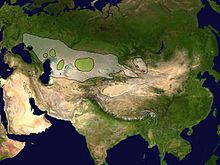
Back Saiga tatarica AN سيغة Arabic سايغا ARZ Сайга AV Sustol (Saiga tatarica) AVK Sayqak Azerbaijani Сайғаҡ Bashkir Сайгак Byelorussian Сайга BE-X-OLD Сайга Bulgarian
| Saiga antelope Temporal range:
| |
|---|---|

| |
| A male at the Stepnoi Nature Sanctuary of Astrakhan Oblast, Russia | |

| |
| A female at the Askania-Nova Biosphere Reserve of Kakhovka Raion, Ukraine | |
| Scientific classification | |
| Domain: | Eukaryota |
| Kingdom: | Animalia |
| Phylum: | Chordata |
| Class: | Mammalia |
| Order: | Artiodactyla |
| Family: | Bovidae |
| Subfamily: | Antilopinae |
| Tribe: | Saigini |
| Genus: | Saiga Gray, 1843 |
| Species: | S. tatarica
|
| Binomial name | |
| Saiga tatarica (Linnaeus, 1766)
| |
| Subspecies | |
| |

| |
| Reconstructed range (white) and current distribution of the two subspecies Saiga tatarica tatarica (green) and S. t. mongolica (red). | |
| Synonyms[2] | |
|
List
| |
The saiga antelope (/ˈsaɪɡə/, Saiga tatarica), or saiga, is a species of antelope which during antiquity inhabited a vast area of the Eurasian steppe, spanning the foothills of the Carpathian Mountains in the northwest and Caucasus in the southwest into Mongolia in the northeast and Dzungaria in the southeast. During the Pleistocene, it ranged across the mammoth steppe from the British Isles to Beringia. Today, the dominant subspecies (S. t. tatarica) only occurs in Kalmykia and Astrakhan Oblast of Russia and in the Ural, Ustyurt and Betpak-Dala regions of Kazakhstan. A portion of the Ustyurt population migrates south to Uzbekistan and occasionally to Turkmenistan in winter. It is regionally extinct in Romania, Ukraine, Moldova, China and southwestern Mongolia. The Mongolian subspecies (S. t. mongolica) occurs only in western Mongolia.[3][4]
- ^ a b IUCN SSC Antelope Specialist Group (2023). "Saiga tatarica". IUCN Red List of Threatened Species. 2023: e.T19832A233712210. Retrieved 11 December 2023.
- ^ Sokolov, V.E. (1974). "Saiga tatarica" (PDF). Mammalian Species (38): 1–4. doi:10.2307/3503906. JSTOR 3503906. Archived from the original (PDF) on 4 March 2016.
- ^ Neronov, V. M.; Arylova, N. Yu.; Dubinin, M. Yu.; Karimova, T. Yu.; Lushchekina, A. A. (2013). "Current state and prospects of preserving saiga antelope in Northwest Pre-Caspian region". Arid Ecosystems. 3 (2): 57–64. Bibcode:2013ArEco...3...57N. doi:10.1134/S2079096113020078. S2CID 18451816.
- ^ "Saiga/mongolian Saiga (Saiga tatarica)". Evolutionarily Distinct and Globally Endangered. Zoological Society of London. Archived from the original on 30 May 2008. Retrieved 19 December 2012.
